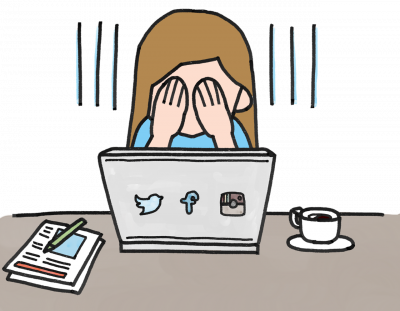6 Steps to Solve Your Tech Addiction
Face it, your relationship with your screens is impacting your daily life in a significant way. The average American looks at their phone approximately 80 times per day (every 12 minutes). That’s an average of 4 hours per day! The average teen consumes 7.5 hours of media per day! So yes, if you’re anything like the average American (and most of us are), I can confidently say that you need to get control of your technology addiction.
As a technology expert that often works with families and young adults, almost 100% of families I work with are dealing with “the screen issue.” Technology addiction can involve cell phones, video games, social media, or a combination of many things that contribute to an overload of media consumption. Family fights typically start with an argument about how much screen time is consumed per day. These arguments often devolve into an argument about how the technology is negatively impact the child. Young adults, using their screens as a vehicle for their social life and entertainment, get extremely defensive about any limits on these areas of their lives. This is happening in most households across America and around the world. It’s time to identify the problem and move towards fixing it.
The bad news is that this is an epidemic that has come on quickly and shows no signs of slowing. The good news is that it’s possible to fix this problem and form a healthy relationship with our screens. Below, you’ll learn about several concrete steps you can take towards solving this problem.
Health and Technology
When I look at any behavior, I view it through the lens of “health.” My job is not to judge any behavior, but rather to help people see how their behavior is affecting them (positively or negatively). There is no definitive definition of “healthy technology use.” There is no agreement about how much time is “too much.” We need technology to navigate our world today, so we must learn how to use it appropriately. In today’s world, it is not an option to “just say no” to all technology and all screens. Let’s look at some simple steps you can take today to have a healthier relationship with technology.
Step 1:
Define what “Healthy Technology Consumption” looks like for yourself?
My hope is that pretty much everyone can identify some dangers of technology addiction. We can all relate to being compelled to check our phones (80 times per day!). Most of us can relate to that zombie feeling once we pull away from our glowing screens. Start by defining how much time you want to use technology per day. Most people report being on social media MUCH MUCH more than they want. For you, healthy technology consumption may look like 1/2 hour per day. For others, 2 hours might be fine. There is no right or wrong answer to what your individual plan looks like.
When I’ve spoken to middle schoolers and high schoolers, most teens admit (away from parent’s judgements) that too much screen time is bad for them. The majority of teens seem to feel that they should limit their screen time to 1-3 hours per day (remember: teens average 7.5 hours per day). For families, I would suggest talking to your child about how they define “healthy use.”
Think of how much better your life could be if you replaced 1-4 hours of screen time per day with something happier/healthier?
Step 2:
Be honest about your usage
Take an honest look at how much media you’re consuming. Warning: you may feel nauseous when you see the actual numbers. For iPhone users, follow these steps to find out how much screen time you’re using per week and which apps get the most attention. For android phones, click here.
I also recommend the Moment app to help track your usage. This app lets you see how your days and weeks compare to each other. Compare where your numbers are currently to where you think “healthy use” should be.
Step 3:
Start “noting”
There are loads of tips for helping you get back in control of your screen time. I recommend practicing a mindfulness technique called “noting”. Start “noting” by just being mindful/aware that you’re on your screen. This technique helps by building clarity around our habits. Watch a short video here that will teach you the basics of this technique.
Step 4:
Use technology to help limit usage
You can start this process by simply deleting social media apps that are wasting your time. Read here about a variety of apps which help limit your actual screen and app time.
Most of us have a few website or apps we compulsively check. For this reason, it’s helpful to limit your access to those websites/apps. If you have an iPhone, click here to learn how to block those websites (don’t worry, you can still access them on other devices if you want).
On your computer, you can also limit certain websites. I recommend using “StayFocused,” which is compatible with the chrome web browser. This program allows you to define how much time you want to spend per day on specific websites and blocks you once you’ve used your daily allotted time.
Another way to limit your usage is by turning your phone to greyscale. By turning off the color on your phone, it’ll make your phone less psychologically attractive. Click here to learn how.
Step 5:
Turn off notifications
Phone notifications need to be turned off. This is easy and makes a world of difference. You don’t need to be alerted/distracted EVERY TIME someone comments on a post, likes a picture, etc. Our phones are constantly buzzing with notifications, begging us to dive back down the internet rabbit hole. Learn how to do this here.
Step 6:
Ask for help
You don’t have to do this alone.
Ask your friends, family, or partner to support your effort to cut down on screen time. Let them know your goals and invite them to be part of the solution. Even a simple, “Hey, can you let me know when I’ve been on my phone too long?” can make a difference. You might be surprised how many people around you are struggling with the same thing and how relieved they are to take on the challenge together.
And if you’re a parent trying to set a better example or guide your child through their own screen struggles, I’ve created a free tool that can help.
Take my 2-minute quiz:
👉 Is Your Child Ready for a Smartphone?
You’ll get a personalized report based on emotional maturity, habits, and tech readiness with clear next steps you can take today.
About the Author

Christopher J. Koniarczyk, Owner Tech Addiction Experts
For years Chris noticed the increasing trend of technology addiction. In 2022 he created Tech Addiction Experts to provide expertise on the issue of technology addiction. He completed his Masters Degree in Counseling Psychology Counselor Education at The University of Colorado Denver in 2011. He is a Licensed Addictions Counselor and a Licensed Professional Counselor in the state of Colorado and a Licensed Clinical Mental Health Counselor in the state of North Carolina. Currently he runs Christopher John Counseling a private therapy practice in Winston-Salem, NC. There he specializes in family, teen, couples, and addiction therapy. In his spare time you can find him spending time with his family, listening to live music, and cheering for the Buffalo Bills.
